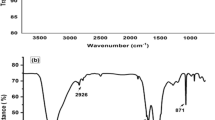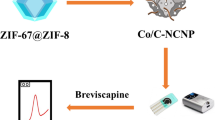Abstract
Nanocomposite nanozeolite/acetylene carbon black was prepared by combining a type A zeolite with acetylene carbon black (AcB) and used to modify glassy carbon electrode (GCE) without polymer. The zeolite was prepared by hydrothermal method using natural kaolin. The physicochemical characterization of the composite showed a well-integrated composite in which the cubic crystal of the zeolite A and the graphitic aggregate of the carbon black were maintained. The electrochemical impedance spectroscopy study revealed that the composite film GCE (ZA-AcB/GCE) prepared by drop coating displayed a higher kinetic charge transfer compared to pristine zeolite modified GCE (ZA/GCE) and bare GCE. ZA-AcB/GCE, ZA/GCE and GCE were subsequently used to investigate the electrochemical behaviour of acetaminophen (AC) in acidic, neutral and alkaline pHs. The results demonstrate a good electrocatalytic property toward AC at composite film GCE in all these electrolytes compared to bare GCE and confirm the dependence of the electrochemical reaction mechanism of AC on the electrolyte’s pHs. Under optimal conditions, ZA-AcB/GCE exhibited higher sensitivity and selectivity toward both analytes taken individually or simultaneously within large concentration range: 0.5–89 µM for AC and 5–99 µM for caffeine (CAF) with the respective limit of detection of 0.38 and 0.82 µM. The developed sensors were applied successfully in the quantification of the both analytes in pharmaceutical tablets.
Graphical abstract











Similar content being viewed by others
References
Renner B, Clarke G, Grattan T, Beisel A, Mueller C, Werner U et al (2007) Caffeine accelerates absorption and enhances the analgesic effect of acetaminophen. J Clin Pharmacol 47(6):715–726
Amiri-Aref M, Raoof JB, Ojani R (2014) A highly sensitive electrochemical sensor for simultaneous voltammetric determination of noradrenaline, acetaminophen, xanthine and caffeine based on a flavonoid nanostructured modified glassy carbon electrode. Sens Actuators, B Chem 192:634–641. https://doi.org/10.1016/j.snb.2013.11.006
Roberts LI (2001) Analgesic-antipyretic and anti-inflammatory agents and drugs employed in the treatment of gout. Goodman & Gilman’s the pharmacological basis of therapeutics
Rashwan WA (2009) The efficacy of acetaminophen–caffeine compared to ibuprofen in the control of postoperative pain after periodontal surgery: a crossover pilot study. J Periodontol 80(6):945–952
Abou-Atme YS, Melis M, Zawawi KH (2019) Efficacy and safety of acetaminophen and caffeine for the management of acute dental pain: a systematic review. Saudi Dent J 31(4):417–423. https://doi.org/10.1016/j.sdentj.2019.04.008
Manchikanti L, Fellows SHB, Janata JW, Pampati V, Grider JS, Boswell MV (2012) Opioid epidemic in the United States. Pain physician 15(3S):ES9
Schachtel BP, Fillingim JM, Lane AC, Thoden WR, Baybutt RI (1991) Caffeine as an analgesic adjuvant. A double-blind study comparing aspirin with caffeine to aspirin and placebo in patients with sore throat. Arch Intern Med 151(4):733–737. https://doi.org/10.1001/archinte.151.4.733
Weiser TW (2022) Chapter 7 - Caffeine as analgesic adjuvant. In: Rajendram R, Patel VB, Preedy VR, Martin CR (eds) Treatments, mechanisms, and adverse reactions of anesthetics and analgesics. Academic Press, Cambridge, pp 63–72
Alam P, Shakeel F, Ali A, Alqarni MH, Foudah AI, Aljarba TM et al (2022) Simultaneous determination of caffeine and paracetamol in commercial formulations using greener normal-phase and reversed-phase hptlc methods: a contrast of validation parameters. Molecules. https://doi.org/10.3390/molecules27020405
Khoshayand MR, Abdollahi H, Shariatpanahi M, Saadatfard A, Mohammadi A (2008) Simultaneous spectrophotometric determination of paracetamol, ibuprofen and caffeine in pharmaceuticals by chemometric methods. Spectrochim Acta A Mol Biomol Spectrosc 70(3):491–499. https://doi.org/10.1016/j.saa.2007.07.033
Yang S, Yang R, Li G, Qu L, Li J, Yu L (2010) Nafion/multi-wall carbon nanotubes composite film coated glassy carbon electrode for sensitive determination of caffeine. J Electroanal Chem 639(1):77–82. https://doi.org/10.1016/j.jelechem.2009.11.025
Martínez-Huitle C, Fernandes NS, Ferro S, De Battisti A, Quiroz M (2010) Fabrication and application of Nafion®-modified boron-doped diamond electrode as sensor for detecting caffeine. Diam Relat Mater 19(10):1188–1193
Yang G, Wang L, Jia J, Zhou D, Li D (2012) Chemically modified glassy carbon electrode for electrochemical sensing paracetamol in acidic solution. J Solid State Electrochem 16(9):2967–2977. https://doi.org/10.1007/s10008-012-1713-8
Rolison DR (1994) The intersection of electrochemistry with zeolite science. Studies in surface science and catalysis, vol 85. Elsevier, Amsterdam, pp 543–586
Walcarius A (1999) Zeolite-modified electrodes in electroanalytical chemistry. Anal Chim Acta 384(1):1–16. https://doi.org/10.1016/S0003-2670(98)00849-6
Gemborys HA, Shaw BR (1986) Electrochemical behavior of methyl viologen in zeolite particle films. J Electroanal Chem Interfacial Electrochem 208(1):95–107. https://doi.org/10.1016/0022-0728(86)90298-6
Li J-W, Calzaferri G (1993) Silver zeolite 4A modified electrodes: intrazeolite effect. J Chem Soc Chem Commun 18:1430–1432. https://doi.org/10.1039/C39930001430
Shaw BR, Creasy KE, Lanczycki CJ, Sargeant JA, Tirhado M (1988) Voltammetric response of zeolite-modified electrodes. J Electrochem Soc 135(4):869–876. https://doi.org/10.1149/1.2095814
Thatikayala D, Noori MT, Min B (2023) Zeolite-modified electrodes for electrochemical sensing of heavy metal ions—progress and future directions. Mater Today Chem 29:101412. https://doi.org/10.1016/j.mtchem.2023.101412
Liu X, Dai L (2016) Carbon-based metal-free catalysts. Nat Rev Mater 1(11):16064. https://doi.org/10.1038/natrevmats.2016.64
İncebay H, Saylakci R (2021) Voltammetric determination of neotame by using chitosan/nickelnanoparticles/multi walled carbon nanotubes biocomposite as a modifier. Electroanalysis 33(6):1451–1460. https://doi.org/10.1002/elan.202100021
Saylakcı R, Incebay H (2021) An electrochemical platform of tannic acid and carbon nanotubes for the sensitive determination of the antipsychotic medication clozapine in pharmaceutical and biological samples. J Electroanal Chem 898:115638. https://doi.org/10.1016/j.jelechem.2021.115638
Zhang H (2006) Electrochemistry and voltammetric determination of colchicine using an acetylene black-dihexadecyl hydrogen phosphate composite film modified glassy carbon electrode. Bioelectrochemistry 68(2):197–201. https://doi.org/10.1016/j.bioelechem.2005.07.001
Santos AM, Wong A, Cincotto FH, Moraes FC, Fatibello-Filho O (2019) Square-wave adsorptive anodic stripping voltammetric determination of norfloxacin using a glassy carbon electrode modified with carbon black and CdTe quantum dots in a chitosan film. Microchim Acta 186(3):148. https://doi.org/10.1007/s00604-019-3268-1
Kemmegne-Mbouguen JC, Tchoumi FP (2023) Synthesis of nanozeolites type A and X from quartz-rich Cameroonian kaolin: application to the modification of carbon paste electrode for acetaminophen and epinine electrochemical sensing. J Solid State Electrochem. https://doi.org/10.1007/s10008-022-05355-z
Huang K-J, Zhang J-Z, Jia Y-L, Xing K, Liu Y-M (2015) Acetylene black incorporated layered copper sulfide nanosheets for high-performance supercapacitor. J Alloy Compd 641:119–126. https://doi.org/10.1016/j.jallcom.2015.04.075
Khoramzadeh E, Mofarahi M, Chung K, Lee C-H (2022) Equilibrium adsorption and kinetic study of CO2 and N2 on synthesized carbon Black-Zeolite composite. Sep Purif Technol 280:119917. https://doi.org/10.1016/j.seppur.2021.119917
Schmidt I, Madsen C, Jacobsen CJH (2000) Confined space synthesis. A novel route to nanosized zeolites. Inorg Chem 39(11):2279–2283. https://doi.org/10.1021/ic991280q
Miao L-X, Wang W-K, Wang A-B, Yuan K-G, Yang Y-S (2013) A high sulfur content composite with core–shell structure as cathode material for Li–S batteries. J Mater Chem A 1(38):11659–11664. https://doi.org/10.1039/C3TA12079A
Andrade-Guel M, Ávila-Orta CA, Cadenas-Pliego G, Cabello-Alvarado CJ, Pérez-Alvarez M, Reyes-Rodríguez P et al (2020) Synthesis of nylon 6/modified carbon black nanocomposites for application in uric acid adsorption. Materials 13(22):5173
Enríquez E, Fernández JF, de la Rubia MA (2012) Highly conductive coatings of carbon black/silica composites obtained by a sol–gel process. Carbon 50(12):4409–4417. https://doi.org/10.1016/j.carbon.2012.05.019
Yu Y, Xiong G, Li C, Xiao F-S (2001) Characterization of aluminosilicate zeolites by UV Raman spectroscopy. Microporous Mesoporous Mater 46(1):23–34. https://doi.org/10.1016/S1387-1811(01)00271-2
Huang Y, Jiang Z (1997) Vibrational spectra of completely siliceous zeolite A. Microporous Mater 12(4):341–345. https://doi.org/10.1016/S0927-6513(97)00082-5
Bärtsch M, Bornhauser P, Calzaferri G, Imhof R (1994) Vibrational structure of zeolite A. In: Weitkamp J, Karge HG, Pfeifer H, Hölderich W (eds) Studies in surface science and catalysis, vol 84. Elsevier, Amsterdam, pp 2089–2098
Nguena KLT, Fotsop CG, Ngomade SBL, Tamo AK, Madu CA, Ezema F et al (2023) Mathematical modeling approach for the green synthesis of high-performance nanoporous zeolites Na-X optimized for water vapor sorption. Mater Today Commun 37:107406. https://doi.org/10.1016/j.mtcomm.2023.107406
Chen X, Wang Y, Wang C, Xu J, Li T, Yue Y et al (2023) Synthesis of NaA zeolite via the mesoscale reorganization of submolten salt depolymerized kaolin: a mechanistic study. Chem Eng J 454:140243. https://doi.org/10.1016/j.cej.2022.140243
Novembre D, Di Sabatino B, Gimeno D, Pace C (2011) Synthesis and characterization of Na-X, Na-A and Na-P zeolites and hydroxysodalite from metakaolinite. Clay Miner 46(3):339–354
Wang C, Yuan R, Chai Y, Chen S, Zhang Y, Hu F et al (2012) Non-covalent iron(III)-porphyrin functionalized multi-walled carbon nanotubes for the simultaneous determination of ascorbic acid, dopamine, uric acid and nitrite. Electrochim Acta 62:109–115. https://doi.org/10.1016/j.electacta.2011.11.115
Nematollahi D, Shayani-Jam H, Alimoradi M, Niroomand S (2009) Electrochemical oxidation of acetaminophen in aqueous solutions: Kinetic evaluation of hydrolysis, hydroxylation and dimerization processes. Electrochim Acta 54(28):7407–7415. https://doi.org/10.1016/j.electacta.2009.07.077
Walcarius A (1996) Zeolite-modified electrodes: analytical applications and prospects. Electroanalysis 8(11):971–986
Fekry A, Shehata M, Azab S, Walcarius A (2020) Voltammetric detection of caffeine in pharmacological and beverages samples based on simple nano-Co (II, III) oxide modified carbon paste electrode in aqueous and micellar media. Sens Actuators B Chem 302:127172
Kalaiyarasi J, Meenakshi S, Gopinath SCB, Pandian K (2017) Mediator-free simultaneous determination of acetaminophen and caffeine using a glassy carbon electrode modified with a nanotubular clay. Microchim Acta 184(11):4485–4494. https://doi.org/10.1007/s00604-017-2483-x
Kemmegne-Mbouguen JC, Angnes L (2015) Simultaneous quantification of ascorbic acid, uric acid and nitrite using a clay/porphyrin modified electrode. Sens Actuators, B Chem 212:464–471. https://doi.org/10.1016/j.snb.2015.02.046
Chitravathi S, Munichandraiah N (2016) Voltammetric determination of paracetamol, tramadol and caffeine using poly(Nile blue) modified glassy carbon electrode. J Electroanal Chem 764:93–103. https://doi.org/10.1016/j.jelechem.2016.01.021
Minh TT, Phong NH, Van Duc H, Khieu DQ (2018) Microwave synthesis and voltammetric simultaneous determination of paracetamol and caffeine using an MOF-199-based electrode. J Mater Sci 53(4):2453–2471
Spãtaru N, Sarada BV, Tryk DA, Fujishima A (2002) Anodic voltammetry of xanthine, theophylline, theobromine and caffeine at conductive diamond electrodes and its analytical application. Electroanal: Int J Devot Fundam Pract Asp Electroanal 14(11):721–728
Tefera M, Geto A, Tessema M, Admassie S (2016) Simultaneous determination of caffeine and paracetamol by square wave voltammetry at poly(4-amino-3-hydroxynaphthalene sulfonic acid)-modified glassy carbon electrode. Food Chem 210:156–162. https://doi.org/10.1016/j.foodchem.2016.04.106
Feyisa TY, Kitte SA, Yenealem D, Gebretsadik G (2020) Simultaneous electrochemical determination of paracetamol and caffeine using activated glassy carbon electrode. Anal Bioanal Electrochem 12:93–106
Mulyasuryani A, Tjahjanto RT, Andawiyah RA (2019) Simultaneous voltammetric detection of acetaminophen and caffeine base on cassava starch—Fe3O4 nanoparticles modified glassy carbon electrode. Chemosensors 7(4):49
Murugan E, Kumar K (2019) Fabrication of SnS/TiO2@GO composite coated glassy carbon electrode for concomitant determination of paracetamol, tryptophan, and caffeine in pharmaceutical formulations. Anal Chem 91(9):5667–5676. https://doi.org/10.1021/acs.analchem.8b05531
Xiong X-Q, Huang K-J, Xu C-X, Jin C-X, Zhai Q-G (2013) Glassy carbon electrode modified with poly (taurine)/TiO2-graphene composite film for determination of acetaminophen and caffeine. Chem Ind Chem Eng Q/CICEQ 19(3):359–368
Acknowledgements
Financial support from the Royal Society ACBI programme (Grant AQ150029) is gratefully acknowledged
Author information
Authors and Affiliations
Contributions
F. P. T.: Conceptualization, Formal analysis, Methodology, Investigation, Validation, Writing original draft, Writing-review and editing A. K. T.: Investigation, Formal analysis, Writing-review and editing G. D.: Formal analysis, Investigation, Writing-review and editing C. G. F.: Formal analysis, Investigation, Writing-review and editing J.C.K.-M.: Conceptualization, Resources, Visualization, Writing-review and editing, Project administration, Funding acquisition E.N.: Supervision, Resources, Funding acquisition, Writing-review and editing
Corresponding author
Ethics declarations
Competing interests
The authors declare no competing interests.
Additional information
Publisher's Note
Springer Nature remains neutral with regard to jurisdictional claims in published maps and institutional affiliations.
Supplementary Information
Below is the link to the electronic supplementary material.
Rights and permissions
Springer Nature or its licensor (e.g. a society or other partner) holds exclusive rights to this article under a publishing agreement with the author(s) or other rightsholder(s); author self-archiving of the accepted manuscript version of this article is solely governed by the terms of such publishing agreement and applicable law.
About this article
Cite this article
Tchoumi, F.P., Tamo, A.K., Doungmo, G. et al. Polymer-free nanocomposite from zeolite and acetylene carbon black as glassy carbon modifier platform for simultaneous electrochemical quantification of acetaminophen and caffeine. J Appl Electrochem (2024). https://doi.org/10.1007/s10800-024-02076-1
Received:
Accepted:
Published:
DOI: https://doi.org/10.1007/s10800-024-02076-1




